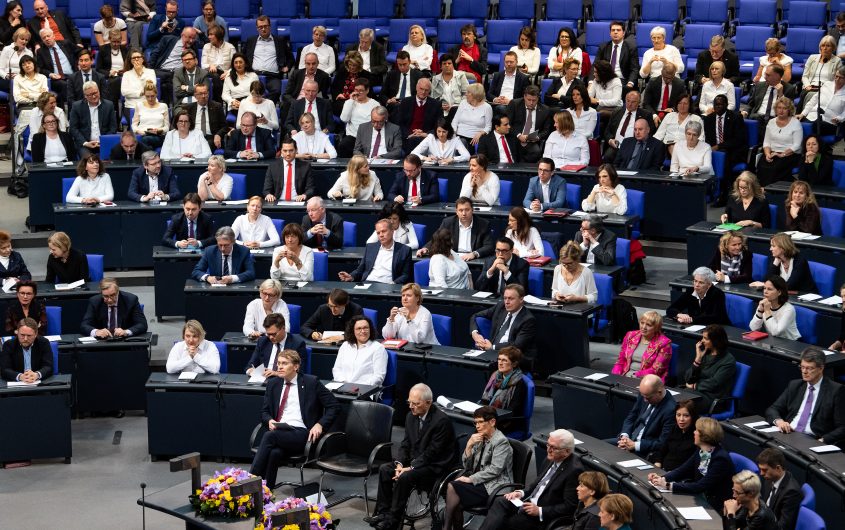
Bernd von Jutrczenka/picture alliance via Getty Images
Necessary but Hardly Sufficient: Assessing a Century of Women’s Suffrage in Germany and the United States

Joyce Mushaben
University of Missouri - St. Louis
Joyce Marie Mushaben is a Curators’ Professor of Comparative Politics and former Director of the Institute for Women's & Gender Studies (2002-2005). Fluent in German, her teaching centers on comparative public policy, the European Union, women's leadership, citizenship, immigration, mega-cities and sustainability issues. Her research covers new social movements, youth protest, German unification and identities, gender, ethnicity and welfare issues, EU migration and integration studies.
Her books/monographs include Identity without a Hinterland? Continuity and Change in National Consciousness in the German Democratic Republic, 1949-1989 (1993); From Post-War to Post-Wall Generations: Changing Attitudes towards the National Question and NATO in the Federal Republic of Germany (1998); The Changing Faces of Citizenship: Integration and Mobilization among Ethnic Minorities in Germany (2008); and, Gendering the European Union: New Responses to Old Democratic Deficits (co-edited with Gabriele Abels, 2012). Her latest book focuses on Becoming Madam Chancellor: Angela Merkel and the Berlin Republic (2016). Her articles have appeared in World Politics, Polity, West European Politics, German Politics, German Politics & Society, the Journal of Peace Research, Democratization, Politics & Religion, Citizenship Studies, Journal of Ethnic & Migration Studies, German Law Review and Femina Politica. A past president of the German Studies Association (USA), she has also served on the Executive Boards of the International Association for the Study of German Politics and the German Studies Association, as well as on selection committees for Fulbright, the German Academic Exchange Service and the American Council of Learned Societies. She is a current Editorial Board member for German Politics & Society, German Politics, and Femina Politica.
Having received a 1999 Trailblazer Award and the Chancellor's Award for Excellence in Research Creativity in 2007, Mushaben is a three-time Alexander von Humboldt Fellow, a former Ford Foundation Fellow, German Marshall Fund grantee and DAAD recipient. She has held guest-scholar posts at the Academy for Social Sciences (GDR), the Center for Youth Research (GDR), the Chinese Academy of Social Sciences and the Center for Transdisciplinary Gender Research (Berlin). She was named the first Research Associate in the BMW Center for German & European Studies at Georgetown University, has enjoyed Visiting Professorships at the Ohio State University, Berlin’s Humboldt University, the Missouri-London Program and at the Universities of Erfurt, Stuttgart and Tübingen (Germany) , inter alia. Affiliated with the American Institute for Contemporary German Politics (Washington D.C.) and a designated Fulbright Specialist, she is commonly known as "Dr. J."
Long before feminists began lobbying for affirmative action, gender mainstreaming, and quotas, suffragettes around the world presumed that the formula “add women, voting rights, and stir” would quickly transform their respective political systems in gender-friendly ways. The last 100 years have revealed a significant gap between descriptive and substantive representation across all branches of government in Germany and the United States. Granted the right to vote in 1918, two years prior to their U.S. counterparts (1920), German women’s long march through the political institutions has been facilitated by a multi-party system utilizing proportionality. Lacking a generous social welfare system, American women had no choice but to lobby long and hard for equal economic opportunities, boosted by the inclusion of “sex” in the 1964 Civil Rights Act. While many European equality advocates looked to the United States for inspiration during the era of second-wave feminism, the conservative backlash unleashed by the Trump administration now has U.S. activists looking to Germany with admiration and envy, particularly in light of gender policies adopted under its first female chancellor, Angela Merkel.
Women in Government
Measured in numerical terms, descriptive representation infers that sex-based stereotypes and discriminatory policies will “wither away” once women comprise 30 percent of the decision-makers, a condition known as critical mass. Initiated in the mid-1980s, Germany’s use of gender quotas in compiling candidate lists (Greens: 50%; SPD 40%; CDU: one out of every three candidates) significantly boosted women’s presence in federal and state parliaments after unification. Women’s share of Bundestag mandates rose from 20.5 percent in 1990 to 31.8 percent in 2005 to 37.3 percent in 2013, dropping to 30.7 percent after the 2017 elections. Recent declines owe to gains made by parties rejecting pro-active female recruitment, i.e., the Alternative for Germany (10 of 92 MdBs) and the FDP (19 of 80). The CSU also lags behind, as demonstrated by interior minister Horst Seehofer’s 2017 appointment of an all-male team of state secretaries; women currently occupy only eight of the CSU’s 47 Bundestag seats.
At the Land level, women account for 37.5 percent of all heads of government, ministers, and senators, ranging from 10 percent in Sachsen-Anhalt, to 70 percent in Rhineland-Pfalz. As of 2018, their share of Landtag seats ranged from 24.5 percent (Baden-Württemberg) to 40.6 percent (Thüringen). Marking 100 years of Frauenwahlrecht in November 2018, CDU chancellor Angela Merkel declared, “quotas are significant, but the goal must be parity.” Only six of her fifteen cabinet members are female, due to an all-male CSU component. Although she initially opposed quotas, she proudly announced in 2018 that 50 percent of all departments in the Federal Chancellor’s Office are currently directed by women.
Brandenburg has recently adopted a “parity law,” the first Land requiring parties to fill half of all candidate slots with women. Although this legislation will likely face a constitutional challenge for contravening party autonomy (Art. 21 Basic Law), other states are likewise considering electoral reforms that would foster “parity,” a concept that Gabriele Abels defines as “a quota at a higher level, albeit legally binding.”[1]
While Germans are now actively committed to equalizing women’s presence in the halls of power, the picture in the United States is a lot gloomier, notwithstanding their 2018 mid-term election surge.
While Germans are now actively committed to equalizing women’s presence in the halls of power, the picture in the United States is a lot gloomier, notwithstanding their 2018 mid-term election surge. The first “Year of the Woman” (1992) was triggered by an all-white-male Senate Judiciary Committee, which deemed sexual harassment charges against Clarence Thomas as irrelevant to his Supreme Court appointment. Prior to 1992, female Congressional representation stood below 6 percent; rising slightly, it hovered between 15 to 17 percent from 2005 to 2012. The 2018 hearings involving Brett M. Kavanaugh’s high court nomination triggered a comparable response, but even the presence of 127 female lawmakers failed to push the United States over the critical mass threshold. Women currently occupy 23.7 percent of all Congressional seats, totaling 25 percent in the Senate, and 23.4 percent in the House. They have nonetheless brought other kinds of diversity into that body; their ranks now include twenty-two Blacks, thirteen Latinas, eight Asian Americans/Pacific Islanders, two Native Americans, and two Muslima. Not a single woman can be found among the Congressional delegations of sixteen states. Concerned about potential age discrimination, second-time presidential candidate Bernie Sanders ought to look in the mirror: Vermont remains the only state in the union that has never sent a woman to either the House or the Senate.
Nor have women attained critical mass at the state level—although women across the U.S. outnumber male voters both in terms of eligibility and turn-out rates. They currently occupy 27.6 percent of all elected state offices, holding only nine of fifty gubernatorial posts. They exercise 28.7 percent of the mandates in all state legislatures (25.6% in senates, 29.8% in state assemblies). They currently fill five of twenty-three chairs (26%) at Trump’s cabinet meetings, compared to 30 to 35 percent under Obama. According to IWPR projections, if women’s representation in Congress continues to increase at current rates, women will not secure numerical parity in Congress until 2121. Trump’s hardline conservative appointments to federal courts over the last two years—courts that have already upheld gerrymandering, voter suppression, and unlimited campaign spending by anonymous donors—will render any gender-equalizing electoral reforms impossible through at least the next election in 2020.
Gender-Sensitive Policymaking
Substantive representation implies that more women in government will result in policies that “level the playing field” between the sexes across both public and private domains. Let us consider two twenty-first century examples: parental leave and corporate management. In 1999, Germany’s Red-Green government adopted gender mainstreaming as a binding operational principle for all federal ministries. With Merkel at the helm, the CDU—the party of Kinder-Küche-Kirche—has embraced many (EU-mandated) reforms that have turned Germany into an astonishingly equality-oriented, family-friendly polity. Among Western women, labor market participation ranged from 48 to 54 percent when the Wall fell. Although over 90 percent of East German women had engaged in paid employment, they were hit by mass unemployment following unification. As of 2018, 75.2 percent of all women had joined the paid labor market, made possible by new parental leave and childcare guarantees, even for toddlers under three—options that were inconceivable twenty years ago. The state pays 67 percent of the average salary (up to €1,800), along with roughly €300 per month (Elterngeld) for up to fourteen months, when both parents avail themselves of leave. Nearly 35 percent of men now take “father-time,” up from 3 percent prior to 2009. In the face of skilled labor shortages, Germany is experiencing its first baby boom since the 1960s.
As of 2018, 75.2 percent of all women had joined the paid labor market, made possible by new parental leave and childcare guarantees.
Rejecting then-labor minister Ursula von der Leyen’s “radical” demand for a female corporate board quota in 2011, Merkel responded to banks behaving badly during the Euro crisis by accepting a binding 30 percent quota in 2015. Women’s share of seats among 3,600 supervisory boards has risen from 2 to 18 to 34 percent in less than six years. As Germany’s first female defense minister, von der Leyen is now transforming even the Bundeswehr, offering parental leave and childcare, flexible work times, diversity initiatives, protection for gay service personnel, and more.
In the United States, the 1993 Family and Medical Leave Act (FMLA) requires employers to protect jobs and provide unpaid leave up to twelve weeks following the birth or adoption of a new child, but the rule applies only to businesses with fifty-plus workers logging at least twenty-five hours per week. Only 56 percent of all laborers are covered, but 20 percent of companies falling under the FMLA are still non-compliant (2014 National Study of Employers). A mere 4 percent of the lowest-wage workers qualify; 45 percent of the potential beneficiaries take no leave, while another one-third cut their leaves short because they cannot afford the wage loss. California, New Jersey, New York, and Rhode Island now warrant paid leave; Washington State, Massachusetts, and the District of Columbia are likewise moving in that direction.
Although 13 percent of high wage earners enjoy paid leave, this has not improved women’s chances of climbing the corporate ladder. Comprising 58 percent of the U.S. labor force, females remain vastly outnumbered at the top: the number leading this country’s largest corporations fell from 32 in 2017 to 24 in 2018. Only twenty-four women currently serve as CEOs of Fortune 500 companies (4.8%), all but two of whom are white. Regarding other non-traditional roles, the Trump White House is once again barring gay and transgendered individuals from military service, and recent court cases are allowing business owners to deny their services to gays (e.g., wedding cakes) based on “religious freedom.”
One hundred years of female suffrage opened the door to women’s (really) long march through the institutions in Germany and the United States, but until women are able to secure their fair share of seats in the places where policies are formulated, decided, implemented, and evaluated, their chances of transforming society in gender-sensitive ways are quite limited.
As this comparison demonstrates, 100 years of female suffrage opened the door to women’s (really) long march through the institutions in Germany and the United States, but until women are able to secure their fair share of seats in the places where policies are formulated, decided, implemented, and evaluated, their chances of transforming society in gender-sensitive ways are quite limited. Ensuring “the balanced participation of women and men” at all stages of the political process lies at the heart of gender mainstreaming, a precept adopted by the European Union in 1996. Much of the progress witnessed in Germany in recent years owes as much to EU pressure as to internal, generationally-driven demands for equal opportunity.
While U.S. voters now accept the presence of female politicians as normal, a winner-take-all system, gerrymandering, and the mind-boggling sums of money required for election campaigns have rendered the political playing field more uneven for women over the last twenty years. The battle over Supreme Court nominations, moreover, suggests that even after a century of female suffrage, what the American state “giveth,” the state can “taketh away.” The real competition for votes that derives from Germany’s multi-party, proportional system—which also makes quotas possible—shows that structures do matter in reinforcing the effectiveness of the women’s vote. But one cannot ignore the normative power of EU equality directives that have added real substance to female representation, confirming the German adage: Ohne Frauen is kein Staat zu machen.
[1] Lecture by Gabriele Abels, “Vom Kampf ums Frauenwahlrecht zur Parité: Politische Repräsentation von Frauen gestern und heute,” Landtag Niedersachsen, Hannover, September 19, 2018.









